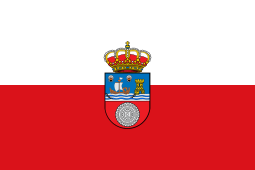
Cantabria is an autonomous community and province in northern Spain with Santander as its capital city. It is called a comunidad histórica, a historic community, in its current Statute of Autonomy. It is bordered on the east by the Basque autonomous community, on the south by Castile and León, on the west by the Principality of Asturias, and on the north by the Cantabrian Sea, which forms part of the Bay of Biscay.

The flag of Chile consists of two equal-height horizontal bands of white and red, with a blue square the same height as the white band in the canton, which bears a white five-pointed star in the center. It was adopted on 18 October 1817. The Chilean flag is also known in Spanish as La Estrella Solitaria.
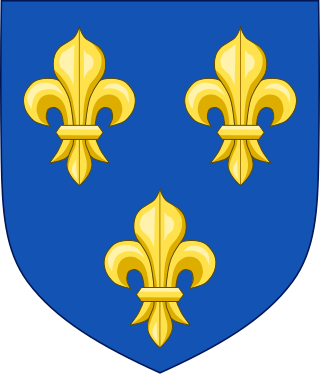
The fleur-de-lis, also spelled fleur-de-lys, is a common heraldic charge in the shape of a lily. Most notably, the fleur-de-lis is depicted on the traditional coat of arms of France that was used from the High Middle Ages until the French Revolution in 1792, and then again in brief periods in the 19th century. This design still represents France and the House of Bourbon in the form of marshalling in the arms of Spain, Quebec and Canada, for example.

A saltire, also called Saint Andrew's Cross or the crux decussata, is a heraldic symbol in the form of a diagonal cross. The word comes from the Middle French sautoir, Medieval Latin saltatoria ("stirrup").
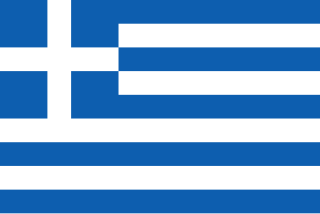
The national flag of Greece, popularly referred to as the "turquoise and white one" or the "azure and white", is officially recognised by Greece as one of its national symbols and has 5 equal horizontal stripes of blue alternating with white. There is a blue canton in the upper hoist-side corner bearing a white cross; the cross symbolises Eastern Orthodox Christianity. The blazon of the flag is Azure, four bars Argent; on a canton of the field a Greek cross throughout of the second. The official flag ratio is 2:3. The shade of blue used in the flag has varied throughout its history, from light blue to dark blue, the latter being increasingly used since the late 1960s. It was officially adopted by the First National Assembly at Epidaurus on 13 January 1822.

The coat of arms of the Philippines features the eight-rayed sun of the Philippines with each ray representing the eight provinces which were placed under martial law by Governor-General Ramón Blanco Sr. during the Philippine Revolution, and the three five-pointed stars representing the three major island groups of Luzon, the Visayas, and Mindanao.

Three Crowns is the national emblem of Sweden, present in the coat of arms of Sweden, and composed of three yellow or gilded coronets ordered two above and one below, placed on a blue background. Similar designs are found on a number of other coats of arms or flags.

The national flag of Spain, as it is defined in the Constitution of 1978, consists of three horizontal stripes: red, yellow and red, the yellow stripe being twice the height of each red stripe. Traditionally, the middle stripe was defined by the more archaic term of gualda, and hence the popular name la Rojigualda (red-weld).

The lauburu is an ancient hooked cross with four comma-shaped heads and the most widely known traditional symbol of the Basque Country and the Basque people. In the past, it has also been associated with the Galicians, Illyrians and Asturians.

The coat of arms of Romania was adopted in the Romanian Parliament on 10 September 1992 as a representative coat of arms for Romania. The current coat of arms is based on the lesser coat of arms of interwar Kingdom of Romania, which was designed in 1921 by the Transylvanian Hungarian heraldist József Sebestyén from Cluj, at the request of King Ferdinand I of Romania, it was redesigned by Victor Dima. As a central element, it shows a golden aquila holding a cross in its beak, and a mace and a sword in its claws. It also consists of the three colors which represent the colors of the national flag. The coat of arms was augmented on 11 July 2016 to add a representation of the Steel Crown of Romania.

The Cantabrian labarum is a modern interpretation of the ancient military standard known by the Romans as Cantabrum. It consists of a purple cloth on which there is what would be called in heraldry a "saltire voided" made up of curved lines, with knobs at the end of each line.

The coat of arms of Cantabria has a rectangular shield, round in base and the field is party en fess. In field azure, a tower or crenellated and masoned, port and windows azure, to its right a ship in natural colours that with its bow has broken a chain sable going from the tower to the dexter flank of the shield. At the base, sea waves argent and azure, all surmounted in chief by two male heads, severed and haloed. In field gules, a disc-shaped stele with geometric ornaments of the kind of the Cantabrian steles of Barros or Lombera. The crest is a closed royal crown, a circle of jeweled gold, made up of eight rosettes in the shape of acanthus leaves, only five visible, interpolated with pearls, and with half-arches topped with pearls raising from each leaf and converging in an orb azure, with submeridian and equator or, topped with cross or. The crown, covered in gules.

The Cantabrian stelae are monolithic stone disks of different sizes, whose early precedents were carved in the last centuries before the romanization of Cantabria in northern Iberian Peninsula. Cantabrian stelae include swastikas, triskeles, crosses, spirals, helixes, warriors or pre-Roman funerary representations among their usual ornamentation. The most famous is called Estela de Barros which can be visited in the Parque de las Estelas in the town of Barros, in Los Corrales de Buelna. This stele is part of the current coat of arms of Cantabria and the meaning of tetraskelion would be related to solar worship. The Barros stele giant size represents the main difference to the smaller stelae found in other parts of northern Spain. In addition to the Estela de Barros, we can see another larger, fragmented stele in the Parque de las Estelas.
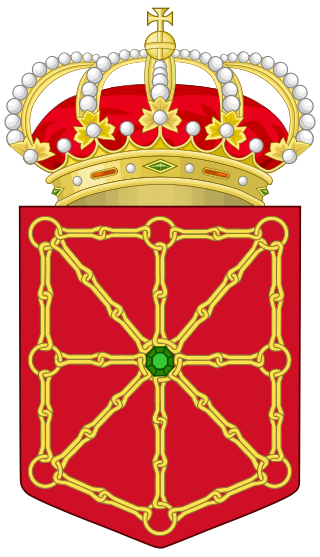
The coat of arms of Navarre is the heraldic emblem which for centuries has been used in Navarre. It was adopted as one of the official symbols of the Chartered Community of Navarre and is regulated by Foral Law 24/2003. It is commonly used by Navarrese municipalities in their own arms.
Cantabrum is the name given by the Roman Empire to the banner used by the Cantabri to facilitate war tactics of the cavalry.
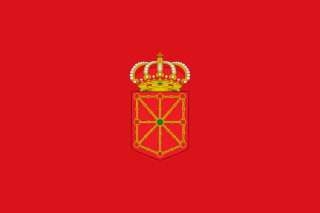
The flag of Navarre, the flag of the autonomous community of Navarre, was designed in 1910 by Arturo Campión, Julio Altadill, and Hermilio de Oloriz. In 1910, the design was approved by the Provincial Council of Navarre and it was sanctioned by the Organic Law of Reintegration and Improvement of the Regional Government of Navarre of August 10, 1982, which was established in Article 7.2: "The flag of Navarre is red-colored, with a shield in the center."

The coat of arms of the Region of Murcia is described in the article 4 of the Spanish Organic Law 4 of 9 June 1982, the Statute of Autonomy of the Region of Murcia and further regulated by Decree 34 of 8 June 1983, approving the official design and use of the coat of arms of the Region of Murcia.

The flag that serves as the symbol of the historical and geographical regions of the Silesia, and Lower Silesia, and as one of the symbols of the Silesian people, is divided horizontally into two stripes: white on the top and yellow on the bottom. It originated as the flag of the Province of Silesia, used from 1882 to 1919, that later used as the flag of the Province of Lower Silesia, from 1920 to 1935. Currently, the flag is recognized symbol of the Silesian people in the state of Saxony in Germany.
